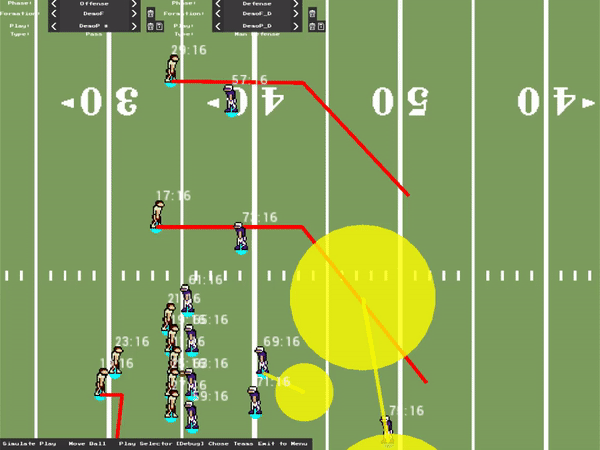31
SFML projects / Re: American Football
« on: April 22, 2019, 04:39:04 pm »
Thanks for taking a look, I'm glad you like it so far. Yup, I'm still working on it as I have time, but there is still a lot of work to be done.
I've taken a break from working on the football simulation aspect of it for a bit and am now focusing on some of the menus. I'm specifically implementing the ability to create new teams/schools from the main menu right now (I say 'schools' because I actually intend for this game to be based on American college football). This means things like being able to customize the team name/colors (the gifs above have the team colors hard coded), and generating a realistic roster.
The roster generation part has been pretty hard to get something implemented I'm happy with. I've had to throw it away and re-do it few times. My first naive approach was to just generate the abilities of each player on the team completely randomly, but as expected this would cause goofy things to happen like randomly making a lineman the fastest player on the team, or making the kicker the best thrower on the team. I've now attempted to put a weight on each ability based on the player's position and how good I want the player to be. My current implementation still isn't perfect, but it's getting closer. I think if I just tune the distributions on my random number generators a little more I can end up with something pretty good.
Hopefully sometime soon I'll have more screenshots/gifs to share.
I've taken a break from working on the football simulation aspect of it for a bit and am now focusing on some of the menus. I'm specifically implementing the ability to create new teams/schools from the main menu right now (I say 'schools' because I actually intend for this game to be based on American college football). This means things like being able to customize the team name/colors (the gifs above have the team colors hard coded), and generating a realistic roster.
The roster generation part has been pretty hard to get something implemented I'm happy with. I've had to throw it away and re-do it few times. My first naive approach was to just generate the abilities of each player on the team completely randomly, but as expected this would cause goofy things to happen like randomly making a lineman the fastest player on the team, or making the kicker the best thrower on the team. I've now attempted to put a weight on each ability based on the player's position and how good I want the player to be. My current implementation still isn't perfect, but it's getting closer. I think if I just tune the distributions on my random number generators a little more I can end up with something pretty good.
Hopefully sometime soon I'll have more screenshots/gifs to share.
 . Though, in case you're not aware, the discussion on these forums tends to not be very geared toward general game design discussion. It's usually more focused towards discussing SFML itself. Like, how to use it, what are some good practices, etc. Specifically, you may have more luck asking about Box2D and how to implement destructible terrain elsewhere. I'll try to give some basic answers to some of your questions though.
. Though, in case you're not aware, the discussion on these forums tends to not be very geared toward general game design discussion. It's usually more focused towards discussing SFML itself. Like, how to use it, what are some good practices, etc. Specifically, you may have more luck asking about Box2D and how to implement destructible terrain elsewhere. I'll try to give some basic answers to some of your questions though.




